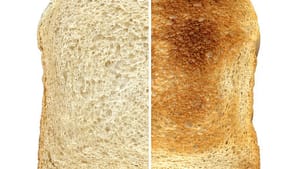Stay in the Loop
BSR publishes on a weekly schedule, with an email newsletter every Wednesday and Thursday morning. There’s no paywall, and subscribing is always free.
The food fad with a difference
Let them eat toast

Think customized coffee is expensive? Wait’ll you see what attaching the adjective artisanal to toast does to the price of Adam and Eve’s raft. In some places, singed bread costs four dollars a slice. That’s without the half-caf, nonfat, free-trade, pesticide-free, water-processed dark roast with a shot of hazelnut foam and a dusting of pomposity.
What is wrong with this picture?
When one can afford to spend four dollars in a café and emerge with a slice of bread and no change for the homeless person outside, one has too much disposable income, period.
Humble toast takes the stage
Philadelphia, characteristically, has put its own spin on the trend. There’s been a restaurant named Toast at 1201 Spruce since 2013. The menu features a long and delicious-sounding list of “egg toasts,” but they’re constructed on English muffins. Toast also has toast, and it’s a relative bargain: just $1.75 (influenced, no doubt, by the city’s sensible Quaker roots).
Over a year ago, the New Yorker reported on the trend, and it’s been skewered by The Salt, a National Public Radio blog. On the Food Network website, you can find 50 Easy Toast Toppers linked to appetizer, cocktail party, dinner party, and even Thanksgiving. I guess we’re to consider placing Tom Turkey on a bed of Melba.
Like the once-humble coffee, tea, and juice — which didn’t always involve shoving the contents of a produce department into a blender — toast has hurtled into the stratosphere of culinary pretention. However, the craze was launched in a much different way.
Toast equals Trouble
In 2014, John Gravois, a writer with Pacific Standard magazine, traced the origin of artisanal toast to Trouble Coffee & Coconut Club, a weird little place with a weirder menu. The club was founded in 2007 in a very unchic neighborhood of San Francisco by Giulietta Carrelli, who had battled schizoaffective disorder for years. Though she had been hospitalized many times, Carrelli’s problem went undiagnosed for a long time, leading to her to seek relief in substances she eventually abused and causing her to become homeless. When she was able, she worked in cafés to earn money and be near people. She had proven herself good at it, if not in sticking in one place.
So Trouble was not born from a shrewd business plan sketched on a paper napkin; it was Carrelli’s self-designed prescription for survival. She’d worked in a number of coffee shops over her then-34 years, so coffee became one of just four items she would serve at Trouble, brewed as “guts” — regular drip — or “honor” — espresso. During a few dark years, Carrelli had lived mostly on grapefruit and coconuts, so she added those odd but nourishing items to the menu. Finally, there was cinnamon toast, a comforting treat her mother had made her as a child, available at Trouble for $3 a slice.
From Trouble came safety
Carrelli’s mental illness was not diagnosed until five years after Trouble opened; despite struggling through psychotic episodes, she kept the place running. Though her health has improved with proper diagnosis and treatment, there are still challenges. Carrelli perseveres, having decided that the best medicine is an unchanging routine and an ever-expanding network of Trouble regulars and neighborhood friends who can help when her symptoms get out of control. When Gravois’s article was published in January 2014, Carrelli employed 14 people and had just opened a second coffee shop in San Francisco. Gravois reported that she planned to open a halfway house for people like herself, in need of a safe place to stay.
Forget the trend but remember the reason
Artisanal toast is an easy way to lampoon the overblown preoccupation with all things food. From high-priest chefs to pretentious cooking shows (channels, websites, books, tools, podcasts, and apps), to perfect meals curated with locally sourced organic ingredients and humanely raised main courses that roamed free in idyllic meadows until they were harvested with bows and arrows (or maybe died of boredom), a lot of time, energy, money, and hubris is devoted to food in a world where millions starve.
As a menu centerpiece, artisanal toast surely won’t last, but while it’s with us, let’s think of it not as a silly mania, but as it was originally intended: a dish served in times of trouble by a woman in need of healing and hope.
Sign up for our newsletter
All of the week's new articles, all in one place. Sign up for the free weekly BSR newsletters, and don't miss a conversation.
